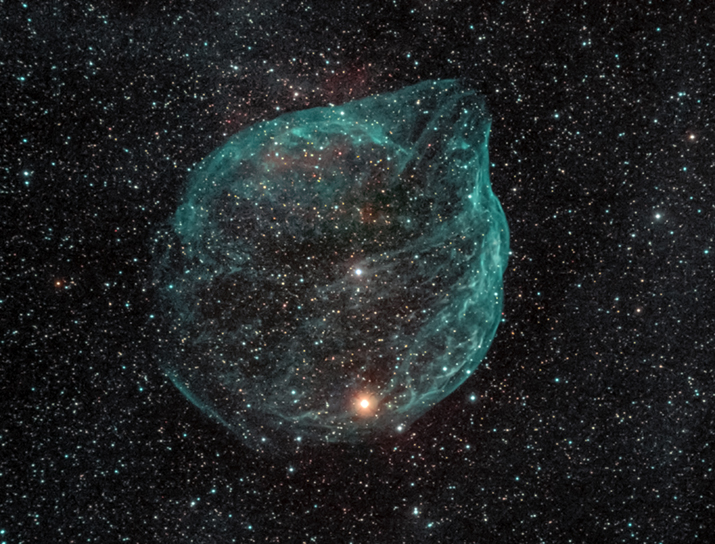
| Date: Feb. 12-14, 2018 - Location: Davis Mountains west of Fort Davis, Texas Telescope: Stellarvue SV102ED - Camera: ST-8300M Filters: Astrodon Ha/OIII Exposure: Ha = 120 min. - OIII = 180 min. Click on the image to view at higher resolution. |

| Sh2-308, as designated in the Sharpless catalog, is a large, faint, bubble of gas expelled from a hot, massive, Wolf-Rayet star. Although measurements vary, the star is approximately 4,900 to 5,200 light-years from the Earth in the constellation Canis Major. It is located about 8 degrees south of the Dog Star, Sirius. Although the nebula appears to be a 2 dimensional "ring" it is actually a spiracle "ball" of gas. The "ring" is a result of looking through more of the gas as it wraps around the edge of the bubble. The nebula is classified as a Wolf-Rayet bubble. The bright star, (EX Canis Majoris or WR 6) in the center of the bubble is the Wolf-Rayet progenitor of the nebula. Wolf-Rayet stars are relatively rare. They are born as very massive stars. As they progress through their short lifespans, they expel a large portion of their mass as very strong stellar winds. This occurs in two phases. The star first expels a large portion of its surface hydrogen as a relatively slower moving stellar wind. In the latter stage of its development, the star expels, at very high velocity, a mixture of heavier gases that slams into, and sweeps up, the slower moving hydrogen. The major portion of the nebula now consists of doubly ionized oxygen. (OIII) Intense ultra-violet radiation from the star excites the nebula to "glow" in the characteristic blue-green color of doubly ionize oxygen. As with all very massive stars, this star is destined to end its life in a supernova explosion. The bright orange star, Omicron 1 Canis Majoris, in the lower portion of the image is not part of the nebula but is a foreground star approximately 610 parsecs (1990 light-years) distant. The image above was captured using Ha (Hydrogen Alpha) and OIII (Doubly Ionized Oxygen) narrowband filters. The image was assembled by mapping Ha to red and OIII to green and blue. This produces a near true color image. |